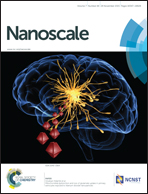A fluorometric microarray with ZnO substrate-enhanced fluorescence and suppressed “coffee-ring” effects for fluorescence immunoassays†
Abstract
A glass slide was first patterned with hydrophobic hexadecyltrimethoxysilane (HDS) and then microspotted with hydrophilic ZnO nanoparticles in an aminopropyltriethoxysilane (APS) matrix. The resulting HDS–ZnO–APS microarray could present the capability of suppressing the undesirable “coffee-ring” effects through its hydrophobic pattern so as to allow the fabrication of ZnO–APS testing microspots with a highly dense and uniform distribution. The lotus-like “self-cleaning” function could also be expected to effectively curb the cross contamination of multiple sample droplets. More importantly, the introduction of ZnO nanoparticles could endow the testing microspots with substrate-enhanced fluorescence leading to signal-amplification microarray fluorometry. The practical application of the developed HDS–ZnO–APS microarray was investigated by the sandwiched fluorometric immunoassays of human IgG, showing a linear detection range from 0.010 to 10.0 ng mL−1. Such a throughput-improved fluorometric microarray could be tailored for probing multiple biomarkers in complicated media like serum or blood.


 Please wait while we load your content...
Please wait while we load your content...